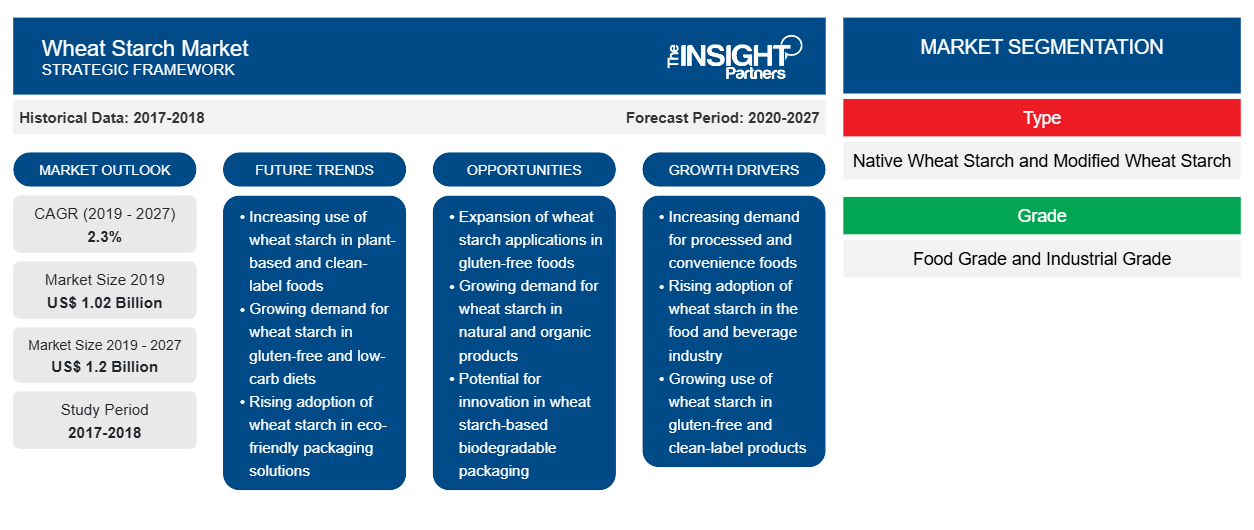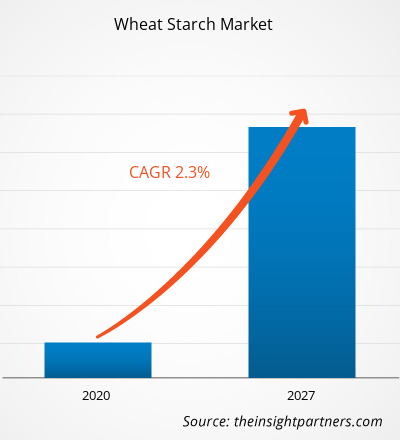The wheat starch market was valued at US$ 1,016.95 million in 2019 and is projected to reach US$ 1,203.32 million by 2027; it is expected to grow at a CAGR of 2.3% during the forecast period.
Wheat starch has superior gelling, stabilizing, and thickening properties. When used in food, wheat starch helps impart the desired texture and viscosity, along with enabling gel formulation, binding, and moisture retention. It is mainly employed as a thickening agent in the food industry. Wheat starch thickens the food through retrogradation and gelatinization. The heat causes the starch to absorb water and swell while increasing the clarity and viscosity. However, once it reaches the maximum viscosity level, the molecules move apart, leading to reduced viscosity. Further, when the product begins to cool again the viscosity increases, thus making the solution cloudy which leads to the formation of the gel. This is one of the reasons why the food and beverage manufactures prefer using wheat starch in food products. The use of heat starch is also increasing in baking these days. The modified wheat starch confers superior emulsifying properties in certain food products. It also finds application in confectioneries such as Turkish delight. It is also effective in improving the head retention in beer. It is also used in the making of sausages and meat rolls. Wheat starch is a major component of pasta and represents about 70% of its weight. Compared to other starch types, wheat starch increases the volume and tenderness of cakes and also helps in fat absorption in doughnuts. Wheat starch is commonly used in sweeteners such as glucose syrup, maltodextrin, and dextrose. It is employed as a stabilizer in sauces and puddings.
Asia Pacific is expected to hold the significant share of the global wheat starch market during the forecast period. Several domestic and international companies have a strong foothold in this region. Rise in middle-class population and growth in urbanization in countries in APAC offer several opportunities for the key wheat starch market players. The easy availability of raw materials (wheat) is instrumental in bolstering the market growth in APAC. China dominated the Asia Pacific wheat starch market in 2019 and is projected to lead the market over the forecast period. The dominance of China is mainly attributed to mounting spending by companies on the development of innovative wheat starch products and the presence of a well-established food and beverages sector in the country
The COVID-19 outbreak was first reported in Wuhan (China) in December 2019, and since then, it has spread at a fast pace across the globe. As of December 2020, the US, India, Brazil, Russia, France, the UK, Turkey, Italy, Spain, Germany, Argentina, Colombia and Mexico are among the worst-affected countries by this pandemic. According to the WHO, as of December there are ~80,773,033 COVID-19 affirmed cases and 1,783,619 death cases worldwide. The COVID-19 has been affecting economies and industries in various countries due to lockdowns, travel bans, and business shutdowns. Food and beverages is one the world’s major industries suffering serious disruptions such as supply chain breaks, technology events cancellations, and office shutdowns. China is the global manufacturing hub and largest raw material supplier for various industries. The lockdown of various plants and factories in China is affecting the global supply chains and negatively impacting the manufacturing, delivery schedules, and material sales. Various companies have already announced possible delays in product deliveries and slump in future sales of their products. In addition to this, the global travel bans imposed by countries in Europe, Asia, and North America are affecting the business collaborations and partnerships opportunities.
Customize This Report To Suit Your Requirement
You will get customization on any report - free of charge - including parts of this report, or country-level analysis, Excel Data pack, as well as avail great offers and discounts for start-ups & universities
Wheat Starch Market: Strategic Insights

-
Get Top Key Market Trends of this report.This FREE sample will include data analysis, ranging from market trends to estimates and forecasts.
Market Insights
Potential Applications of Wheat Starch in Pharmaceutical Formulations Drive Market Growth
Researchers and pharmacists across the world are taking efforts to discover the potential of modified starch in pharmaceutical formulations to leverage the improved functionalities and applicability of this starch. The studies are focused on basic requirements of pharmaceutical excipients and starch modification methods such as chemical, biotechnological, and physical methods. Starch derived from wheat, maize, rice and others are colorless, odorless, and insoluble in alcohol and water. In pharmaceuticals production, starch acts as an important excipient that is versatile and cheap. The native wheat starch is being well explored as a binder and disintegrant in solid dosage forms. The starch is being modified to enhance its physicochemical properties such as texture, stability, and viscosity to have a good flow ability and compressibility in pharmaceutical applications. Thus, the modified starch is now being preferred as directly compressible excipients in the pharmaceuticals industry, which is propelling the wheat starch market growth.
Type Insights
On the basis of type, the wheat starch market is segmented into native wheat starch and modified wheat starch. In 2019, the native wheat starch segment dominated the market. The physical extraction of wheat starch separates gluten and other proteins. Native wheat starch is also a plant-based component used in foods derived from wheat. It is a white to off-white powder with a neutral smell and taste. It has an energy value of 4 kcal/g, i.e., similar to all other carbohydrates. Native wheat starch is used as a thickening, stabilizing, clouding, and glazing agent; moreover, it can also be used for binding and moisture retention. It is used in sugar confectioneries, bakery products, snacks, dairy products (such as cheese), alcoholic beverages, sauces and soups, pasta, ready meals, and meat and seafood (such as surimi).
Grade Insights
On the basis of grade, the wheat starch market is segmented into food grade and industrial grade. In 2019, the food grade segment dominated the market. Wheat starch is commonly used as a dietary supplement in the food and beverages sector; it can be also used as a fat substitute. It acts as a thickening agent in food through the processes of gelatinization and retrograde. The food-grade wheat starch is used to thicken or strengthen products such as puddings, soups, sauces, and pie fillings. It helps with texture, viscosity, gel-forming, adhesion, binding, and moisture retention. This starch is also an essential material in high-quality restaurants, hotels, and domestic cooking applications.
End Use Industry Insights
Based on end use industry, the wheat starch market is segmented into food and beverages, cosmetics, and others. In 2019, the food and beverages segment dominated the market. In the food industry, wheat starch is used as a thickening agent. Moreover, its ability to prevent elasticity in dough, it is most widely used in the food and beverage sector as a thickener, food additive, and active ingredient. Furthermore, it is helpful in the food binding process and also used in the preparation of foods that are gluten-free and low in calories. In many food applications, it is also commonly used as an emulsifier, stabilizer, fat substitute, and clouding or glazing agent. It is also used in dough recipes of Chinese dumpling wrappers as it helps give translucent consistency to dumpling wrappers. The trend for the consumption of gluten-free food among consumers would continue to favor the use of wheat starch in the food and beverage industry.
Key players present in the global wheat starch market include Cargill Incorporated, RoquetteFreres, Manildra Group, MGP Ingredients, The Archer-Daniels-Midland Company, Agrana Group, Tereos SA, Crespel and Deiters, New Zealand Starch Company, and SacchettoS.p.A. These companies are implementing new product developments, and mergers and acquisitions strategies to expand their customer base and gain significant market share across the world, which, in turn, permits them to maintain their brand name globally.
Wheat Starch Market Regional InsightsThe regional trends and factors influencing the Wheat Starch Market throughout the forecast period have been thoroughly explained by the analysts at The Insight Partners. This section also discusses Wheat Starch Market segments and geography across North America, Europe, Asia Pacific, Middle East and Africa, and South and Central America.
Wheat Starch Market Report Scope
| Report Attribute | Details |
|---|---|
| Market size in 2019 | US$ 1.02 Billion |
| Market Size by 2027 | US$ 1.2 Billion |
| Global CAGR (2019 - 2027) | 2.3% |
| Historical Data | 2017-2018 |
| Forecast period | 2020-2027 |
| Segments Covered |
By Type
|
| Regions and Countries Covered |
North America
|
| Market leaders and key company profiles |
|
Wheat Starch Market Players Density: Understanding Its Impact on Business Dynamics
The Wheat Starch Market is growing rapidly, driven by increasing end-user demand due to factors such as evolving consumer preferences, technological advancements, and greater awareness of the product's benefits. As demand rises, businesses are expanding their offerings, innovating to meet consumer needs, and capitalizing on emerging trends, which further fuels market growth.

- Get the Wheat Starch Market top key players overview
Report Spotlights
- Progressive industry trends in the global wheat starch market that help players develop effective long-term strategies
- Business growth strategies adopted by companies in developed and developing markets
- Quantitative analysis of the wheat starch market from 2017 to 2027
- Estimation of wheat starch demand across various industries
- PEST analysis to illustrate the efficacy of buyers and suppliers operating in the industry
- Recent developments to understand the competitive market scenario and wheat starch demand
- Market trends and outlook, and factors driving and restraining the growth of the market
- Understanding of strategies that underpin commercial interest with regard to the market growth
- Wheat starch market size at various nodes of market
- Detailed overview and segmentation of the market, as well as its industry dynamics
- Global wheat starchmarket size in various regions with promising growth opportunities in the respective regions
Wheat Starch Market, by Type
- Native Wheat Starch
- Modified Wheat Starch
Wheat Starch Market, by Grade
- Food Grade
- Industrial Grade
Wheat Starch Market, by End Use Industry
- Food and Beverages
- Cosmetics
- Others
Company Profiles
- Cargill Incorporated
- RoquetteFreres
- Manildra Group
- MGP Ingredients
- The Archer-Daniels-Midland Company
- Agrana Group
- Tereos SA
- Crespel and Deiters
- New Zealand Starch Company
- Sacchetto S.p.A
Frequently Asked Questions
Based on type, which segment is leading the global wheat starch market during the forecast period?
Can you list some of the major players operating in the global wheat starch market?
Which region held the largest share of the global wheat starch market?
- Historical Analysis (2 Years), Base Year, Forecast (7 Years) with CAGR
- PEST and SWOT Analysis
- Market Size Value / Volume - Global, Regional, Country
- Industry and Competitive Landscape
- Excel Dataset
Recent Reports
Testimonials
Reason to Buy
- Informed Decision-Making
- Understanding Market Dynamics
- Competitive Analysis
- Identifying Emerging Markets
- Customer Insights
- Market Forecasts
- Risk Mitigation
- Boosting Operational Efficiency
- Strategic Planning
- Investment Justification
- Tracking Industry Innovations
- Aligning with Regulatory Trends





















 Get Free Sample For
Get Free Sample For